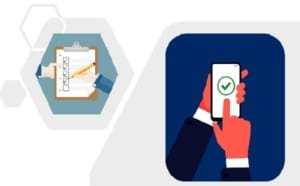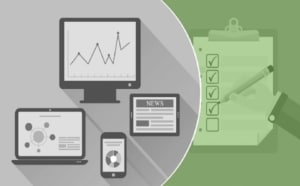
Phil Hearn: Blogger, Writer & Founder of MRDC Software Ltd.
Should all market research software be online?
Market research has adopted technology at varying speeds in its history, often at a different rate to other industries. Why is this? Is it important? CAPI (Computer-assisted personal interviewing), CAWI (web interviewing), CATI (telephone interviewing), tabulations, reporting and dashboarding all pose different wants and needs. This article aims to look at each type of software used in market research and discuss the importance of each type being online, offline or both – and, more importantly, where market research should be heading and what MRDC Software’s perspective is as a research software specialist.
The past, the present and the future
Let me try to summarise market research as far as technology in one paragraph. As an industry, it led back in the 1970s by being proficient and making complex analysis and large-scale analysis possible. It adapted to the opportunities offered by CATI in the 1990s, but then advances started to fall behind other industries. Whilst technology roared ahead in most businesses from the late 1990s, market research moved forward more slowly. The PowerPoint presentation is still the end product of a significant slice of market research business. In the future, market research needs to be as convenient as the many apps we use daily without much thought.
The online survey changed everything, didn’t it?
The arrival of online surveys meant a big change in research. It meant a lot of things, but predominantly, it meant cheaper, faster, shorter surveys. This led to the demand for faster delivery of results. However, the end product has often remained as tabulations and PowerPoint presentations. Why is that? And shouldn’t everything be online? Before we look at each type of software in a little more depth. Does it matter if the software is online?
What the client sees matters
I believe what goes on in the engine room doesn’t matter much. What the client sees does matter. I don’t really care how my car is built, whether robots are used, whether someone puts parts together manually – all I care about is whether the vehicle I drive serves me the way I want. The same is true about market research. So, to extend that argument, where the buyer ‘touches’ market research is at the end when they receive the results – that’s the bit where market research has been slow to move.
What has market research made efficient?
I would argue that market research as an industry has tended to make the ‘engine room’ bits more efficient. We can produce hundreds, even thousands of tabulations quickly, and we can prepare questionnaires efficiently, but these are things that the client essentially doesn’t see. These things keep our costs down but do not improve the customer’s customer journey, to use an overused term in our industry. So, let’s look at each type of software in more depth.
1. CAPI – Questionnaire Preparation
At first sight, it doesn’t matter whether a CAPI questionnaire is prepared online or offline on a desktop or laptop computer. However, the way we work is changing. Without realising it, perhaps, we are getting used to being connected. We can share files quickly or show our screen to a colleague or client online in seconds. Questionnaire development used to be a lonely task, but communication means that we need to be online, in my view. Explaining an issue to a client by email or telephone takes far more time than allowing a client access to view themselves. It’s better if it is online.
2. CAPI – interviewing
The actual survey interview needs to be online and offline. Poor reception, black spots and unpredictable signal strength occur worldwide, including in European city centres. The software collecting the data needs to work both online and offline, meaning that if there is an inadequate internet connection, the data is stored on a local device and uploaded, preferably automatically, when there is a connection. There are still several CAPI products that work either online or offline only – but not both.
3. CATI
For questionnaire preparation, the same is true for CATI surveys as it is for CAPI surveys. For interviewing, it is generally unimportant. Clients will see no benefit except that they cannot log in and monitor project progress. I would also argue that relying on an internet connection could be risky. If the connection drops, you could have 20 or more interviewers unable to work or with unfinished interviews. Of course, the same is true of a network, but at locations where internet speeds waver, a hardware network is usually preferable.
4. CAWI
For questionnaire preparation, it is a must. Clients expect to be able to see their survey ‘in action’, including survey progress, latest results etc. This is simply because we are all used to seeing what is going on when things are online, so for online surveys, it’s an expectation, not a nice-to-have.
5. Tabulations/Analysis – the heavy number crunching
Producing tabulations or running statistical analysis is generally a hidden operation at most research agencies. I don’t think clients need to see the heavy number crunching that we regularly carry out on market research projects. Added to this is the fact that processing can be heavy, and desktop processing is simply faster and more productive. However, some good online tabulation platforms are suitable for many surveys, even if they struggle with large or complex surveys.
6. Tabulations/Analysis – giving access to the data
Access to the data for quick counts or key figures is often desirable. This can be approached in two ways – one is to use a fully online system, and the other is to have a back-end tool that allows clients or data users access to the data online or in some easily distributed way. The first method works well for many online surveys as online surveys tend to contain smaller amounts of data with shorter questionnaires. The second method is more appropriate for large-scale projects or tracking studies.
7. Reporting
I am still pained by how PowerPoint presentations are heavily used to disseminate findings from research projects. I recall that back in 1997, I presented some data and made the session interactive by setting up something in Excel that could perform calculations and charts on request during the presentation. Yet, much research is still presented as static reports. I hope this changes.
8. Dashboards/Interactive Analytics
Dashboards and interactive analytics are the way to go forward. This is not new technology, but it has been slow to be adopted by market research for two key reasons – firstly, the software has been expensive and, secondly, the tools are not really geared to the peculiarities of market research data – for example, multiple response questions, hiding data with low bases, significance tests etc.






